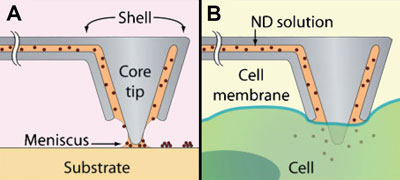| Posted: May 22, 2009 |
'Fountain pen' injects nanodiamonds |
|
(Nanowerk News) Researchers in the US have created a 'fountain pen' probe that can pattern nanodiamonds at high resolution and inject them into single cells. The probe could be used as a research and development tool for creating nanodiamond devices and exploring the effect of single cells carrying medical drugs ("Nanofountain-Probe-Based High-Resolution Patterning and Single-Cell Injection of Functionalized Nanodiamonds").
|
|
Nanodiamonds have several unique properties that make them attractive in biomedicine: they have a high surface area for their volume, they are bio-compatible, and - although no-one is quite sure how - they are able to steadily release drugs that have been attached to them.
|
|
However, scientists have found it challenging to control the placement of nanodiamonds precisely, which is crucial for creating nanodiamond-based devices or for injecting nanodiamonds into cells. There has been some success by adopting techniques similar to ink-jet printing, but even the best resolution offered by these, which is in the order of 100µm, is not fine enough.
|
 |
| For direct-write nanopatterning (A), the tip is brought into contact with the substrate where an ink meniscus forms. For in vitro cellular injection (B), the tip is introduced to the cell membrane with a prescribed insertion force. (Image: Small)
|
|
Now, Horacio Espinosa and others at Northwestern University in Evanston, US, have created a tool that they say offers more control over nanodiamond placement. It consists of the probe of an atomic force microscope that has been modified to house a reservoir filled with an 'ink' of nanodiamonds in solution. 'It's just like a fountain pen,' said Owen Loh, a member of the group.
|
|
Such nanofountain probes have been employed for placement of nanoparticles before, but never with nanodiamonds. In one mode, the Northwestern group's probe can pattern nanodiamonds onto a substrate with a resolution better than 100nm, three orders of magnitude finer than previously achievable. Loh told Chemistry World this ability could help seed the growth of nanodiamond thin films. In the past, nanodiamond thin films have been shown, for example, to prevent the re-growth of tumours when combined with anti-cancer drugs and implanted into the human body.
|
|
|
|
In a second mode, the probe can inject nanodiamonds into single cells. Until now it had only been possible to test nanodiamond drug delivery on populations of cells, and Loh said that the potential for more precise application will help scientists understand how drug-laden cells interact with their neighbours.
|
|
The group is presently collaborating with biologists and focusing on how to exploit the benefits of single-cell injection. 'The key part is that [both modes] are in the same tool, so researchers only need to familiarise themselves with one tool,' Loh added.
|

